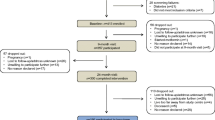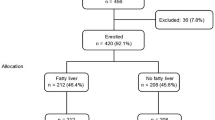Abstract
Background
Non-alcoholic fatty liver disease (NAFLD) is an independent predictor of type 2 diabetes mellitus (T2DM). Insulin resistance and beta-cell dysfunction are involved in the pathogenesis of T2DM. Insulin resistance is associated with NAFLD but little is known about beta-cell dysfunction and NAFLD.
Aim
We tested whether NAFLD severity is associated with insulin sensitivity and beta-cell function in morbidly obese women.
Subjects and methods
We studied 61 Caucasian women aged 18–60 years without T2DM and with a body mass index ranging from 35.3 to 48.8 kg/m2. The insulin sensitivity index (ISI) and the disposition index (DI) from oral glucose tolerance testing were used as measures of insulin sensitivity and beta-cell function, respectively. Fat was measured by dual-energy X-ray absorptiometry. Fatty liver was diagnosed by ultrasonography and ordinally coded as 0 = none, 1 = light, 2 = moderate, 3 = severe. Proportional-odds logistic regression was used to evaluate the association of NAFLD severity with logeISI and logeDI with and without correction for total and truncal fat.
Results
The odds of more severe vs. less severe NAFLD decreased for increasing logeISI [odds ratio (OR) 0.40, 95 % CI 0.19–0.84, p < 0.05] and logeDI (OR 0.80, 95 % CI 0.69–0.92, p < 0.01). Neither total nor truncal fat had any effect on these associations.
Conclusion
In morbidly obese women, NAFLD severity is inversely associated with insulin sensitivity and beta-cell function. The association of NAFLD severity with beta-cell dysfunction is stronger than that with insulin resistance.

Similar content being viewed by others
References
Vernon G, Baranova A, Younossi ZM (2011) Systematic review: the epidemiology and natural history of non-alcoholic fatty liver disease and non-alcoholic steatohepatitis in adults. Aliment Pharmacol Ther 34:274–285
Musso G, Gambino R, Cassader M et al (2011) Meta-analysis: natural history of non-alcoholic fatty liver disease (NAFLD) and diagnostic accuracy of non-invasive tests for liver disease severity. Ann Med 43:617–649
Lattuada G, Ragogna F, Perseghin G (2011) Why does NAFLD predict type 2 diabetes? Curr Diab Rep 11:167–172
DeFronzo RA (2009) Banting Lecture. From the triumvirate to the ominous octet: a new paradigm for the treatment of type 2 diabetes mellitus. Diabetes 58:773–795
Gastaldelli A, Ferrannini E, Miyazaki Y et al (2004) Beta-cell dysfunction and glucose intolerance: results from the San Antonio metabolism (SAM) study. Diabetologia 47:31–39
DeFronzo RA, Tripathy D, Schwenke DC et al (2013) Prevention of diabetes with pioglitazone in ACT NOW: physiologic correlates. Diabetes 62:3920–3926
Gaggini M, Morelli M, Buzzigoli E et al (2013) Non-alcoholic fatty liver disease (NAFLD) and its connection with insulin resistance, dyslipidemia, atherosclerosis and coronary heart disease. Nutrients 5:1544–1560
Bedogni G, Bellentani S, Miglioli L et al (2006) The fatty liver index: a simple and accurate predictor of hepatic steatosis in the general population. BMC Gastroenterol 6:33
Gastaldelli A, Kozakova M, Højlund K et al (2009) Fatty liver is associated with insulin resistance, risk of coronary heart disease, and early atherosclerosis in a large European population. Hepatology 49:1537–1544
Rijkelijkhuizen JM, Doesburg T, Girman CJ et al (2009) Hepatic fat is not associated with beta-cell function or postprandial free fatty acid response. Metabolism 58:196–203
Bedogni G, Gastaldelli A, Agosti F et al (2012) Impact of percent body fat on oral glucose tolerance testing: a cross-sectional study in 1512 obese children. J Endocrinol Invest 35:893–896
Park SH, Kim BI, Kim SH et al (2007) Body fat distribution and insulin resistance: beyond obesity in nonalcoholic fatty liver disease among overweight men. J Am Coll Nutr 26:321–326
Subramanian V, Johnston RD, Kaye P et al (2013) Regional anthropometric measures associated with the severity of liver injury in patients with non-alcoholic fatty liver disease. Aliment Pharmacol Ther 37:455–463
Bedogni G, Grugni G, Nobili V et al (2014) Is non-alcoholic fatty liver disease less frequent among women with Prader-Willi syndrome? Obes Facts 7:71–76
Bedogni G, Agosti F, De Col A et al (2013) Comparison of dual-energy X-ray absorptiometry, air displacement plethysmography and bioelectrical impedance analysis for the assessment of body composition in morbidly obese women. Eur J Clin Nutr 67:1129–1132
Lohman TG, Roche AF, Martorell R (1988) Anthropometric standardization reference manual. Human Kinetics Books, Champaign
WHO (2000) Obesity: preventing and managing the global epidemic: report of a WHO consultation. World Health Organization, Geneva
World Health Organization (WHO) (2006) Definition and diagnosis of diabetes. WHO, Geneva
Matsuda M, DeFronzo RA (1999) Insulin sensitivity indices obtained from oral glucose tolerance testing: comparison with the euglycemic insulin clamp. Diabetes Care 22:1462–1470
Bedogni G, Gastaldelli A, Manco M et al (2012) Relationship between fatty liver and glucose metabolism: a cross-sectional study in 571 obese children. Nutr Metab Cardiovasc Dis 22:120–126
Bedogni G, Kahn HS, Bellentani S et al (2010) A simple index of lipid overaccumulation is a good marker of liver steatosis. BMC Gastroenterol 10:98
Hernaez R, Lazo M, Bonekamp S et al (2011) Diagnostic accuracy and reliability of ultrasonography for the detection of fatty liver: a meta-analysis. Hepatology 54:1082–1090
Ratziu V, Bellentani S, Cortez-Pinto H et al (2010) A position statement on NAFLD/NASH based on the EASL 2009 special conference. J Hepatol 53:372–384
Agresti A (2010) Analysis of ordinal categorical data. Wiley, Hoboken
Hosmer DW, Lemeshow S, Sturdivant RX (2013) Applied logistic regression. Wiley, Hoboken
Belsey DA, Kuh E, Welsch RE (1980) Regression diagnostics identifying influential data and sources of collinearity. Wiley, New York
Royston P, Sauerbrei W (2008) Multivariable model-building: a pragmatic approach to regression analysis based on fractional polynomials for modelling continuous variables. Wiley, Chichester
Long JS, Freese J (2006) Regression models for categorical dependent variables using Stata. StataCorp, College Station
Nobili V, Alisi A, DellaCorte C et al (2013) Docosahexaenoic acid for the treatment of fatty liver: Randomised controlled trial in children. Nutr Metab Cardiovasc Dis 23:1066–1070
Acknowledgments
This study was supported by Progetti di Ricerca Corrente, Istituto Auxologico Italiano, Verbania and Milan, Italy.
Conflict of interest
None.
Author information
Authors and Affiliations
Corresponding author
Rights and permissions
About this article
Cite this article
Bedogni, G., Gastaldelli, A., Tiribelli, C. et al. Relationship between glucose metabolism and non-alcoholic fatty liver disease severity in morbidly obese women. J Endocrinol Invest 37, 739–744 (2014). https://doi.org/10.1007/s40618-014-0101-x
Received:
Accepted:
Published:
Issue Date:
DOI: https://doi.org/10.1007/s40618-014-0101-x




